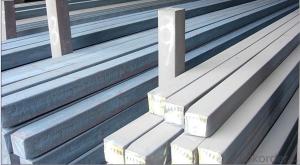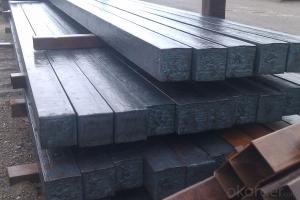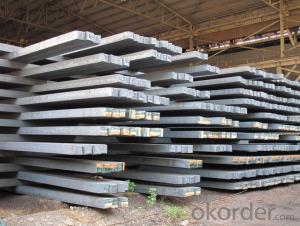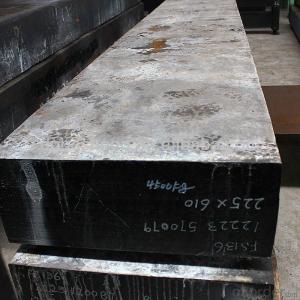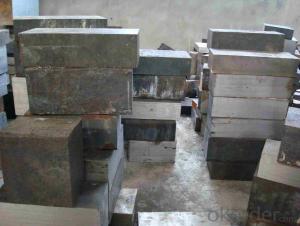Prime quality square alloy steel billet 130mm Q235
- Loading Port:
- Tianjin
- Payment Terms:
- TT OR LC
- Min Order Qty:
- 100 m.t.
- Supply Capability:
- 10000 m.t./month
OKorder Service Pledge
OKorder Financial Service
You Might Also Like
Structure of Prime quality square alloy steel billet 130mm Q235

Description of Prime quality square alloy steel billet 130mm Q235
1. Prepainted steel coil is coated with organic layer, which provides higher anti-corrosion property and a longer lifespan than that of galvanized or galvalume steel sheets.
2. The base metals for prepainted steel coil consist of cold rolled, HDGI Steel, electro-galvanized and hot-dip alu-zinc coated steel. The finish coats of prepainted steel coil can be classified into groups as follows: polyester, silicon modified polyesters, polyvinylidene fluoride, high-durability polyester, etc.
3. The production process has evolved from one-coating-and-one-baking to double-coating-and-double-baking, and even three-coating-and-three-baking.
4. The color of the prepainted steel coil has a very wide selection, like orange, cream-colored, dark sky blue, sea blue, bright red, brick red, ivory white, porcelain blue, etc.
5. The prepainted steel coils can also be classified into groups by their surface textures, namely regular prepainted sheets, embossed sheets and printed sheets.

Main Feature of Prime quality square alloy steel billet 130mm Q235
Uncoated CR steel sheet
With the features of in line with the international highest standards in demension and shape, excellent surface finish and properties, the products are mainly used in home appliance and automobile industries.
Galvanized steel sheet(include HDG and EG)
With the features of good corrosion resistance, the products are mainly used in automobile, home appliance, electronics, building and machinery manufacture industries, etc.
Precoated steel sheet
With the features of enviromental protection and good processablility, long lasting surface durability, rich in colors, the products are maily used in building, home appliance and furniture industries, etc.
Applications of Prime quality square alloy steel billet 130mm Q235
Construction
Manufacture anticorrosion, industrial and civil architecture roof boarding, roof grille
Light industries
Home appliance's case, civil chimney, kitchen utensils
Auto industry
Corrosion resistant parts of cars
Agriculture
Food storage, meat and aquatic products' freezing and processing equipment
Commerce
Equipments to store and transport materials, and packing implements

Specifications of Prime quality square alloy steel billet 130mm Q235
Product | Prime quality square alloy steel billet 130mm Q235 |
Material Grade | SGCC / SGCH / DX51D+AZ, etc |
Thickness | 0.6-3.0mm |
Width | 500-1500mm |
Tolerance | Thickness: +/-0.02mm , Width:+/-2mm |
Zinc-coating | Z30-150g/m2 |
Technique | Raw material: Hot rolled steel coil --> Cold rolled_>hot dipped galvalume |
Surface | Dried, Chromated, Unoiled |
Spangle | Regular spangle , small spangle, zero spangle |
ID | 508MM 610MM |
Coil weight | 1-25MT |
Export package | Cardboard inner sleeves, Waterproof paper, galvanized steel covered and steel strip packed |
FAQ of Prime quality square alloy steel billet 130mm Q235
We have organized several common questions for our clients,may help you sincerely:
1. How Can I Visit There?
Our company is located in Tianjin City, China, near Beijing. You can fly to Tianjin Airport Directly. All our clients, from home or aboard, are warmly welcome to visit us!
2. How Can I Get Some Sample?
We are honored to offer you sample.
3. Why choose CNBM?
Our delivery time about 15-20days for standard sizes, if you have other requirements like hardness, quanity and width ,it is about 20-40days. But don't worry we also try our best for the delivery time ,because time longer and our cost is higher.
- Q:What are the potential applications of steel billets in the electronics aftermarket?
- The electronics aftermarket offers numerous possibilities for the use of steel billets. One potential application involves utilizing them for the production of electronic enclosures or casings. By machining and shaping steel billets, we can create robust and dependable enclosures that effectively safeguard electronic components. These enclosures provide durability and protection against environmental factors like moisture, dust, and impact. Furthermore, steel billets can play a role in manufacturing various electronic components. For instance, they can be employed to produce connectors, pins, sockets, and other essential small parts necessary for electronic devices. The high strength and conductivity of steel make it an ideal material for these components, ensuring reliable performance and efficient signal transmission. Additionally, steel billets find use in the creation of heat sinks for electronic devices. Heat sinks are vital in dissipating the heat generated by electronic components, preventing overheating, and potential performance issues or component failure. Steel's excellent thermal conductivity makes it a suitable material for heat sinks, allowing efficient heat transfer and ensuring the proper functioning of electronic devices. Moreover, steel billets can be utilized in manufacturing racks and cabinets used for housing and organizing electronic equipment. These structures provide a safe and secure environment for storing and accessing electronic devices in various settings, such as data centers, telecommunications facilities, or server rooms. Steel's durability and load-bearing capabilities make it an ideal choice for such applications, ensuring the protection and organization of electronic equipment. To summarize, steel billets offer a wide range of potential applications in the electronics aftermarket. Whether it is for producing enclosures, electronic components, heat sinks, or racks and cabinets, steel's strength, conductivity, durability, and thermal properties make it a versatile material for various electronic applications.
- Q:How are steel billets inspected for internal defects?
- Steel billets are inspected for internal defects using various non-destructive testing (NDT) techniques. One common method is ultrasonic testing (UT), where high-frequency sound waves are used to detect defects inside the billet. A transducer sends ultrasonic waves into the billet, and the reflected waves are analyzed to identify any internal flaws. UT is capable of detecting defects such as cracks, voids, inclusions, and other discontinuities. Another method employed is magnetic particle inspection (MPI). This technique is particularly useful for detecting surface and near-surface defects in ferromagnetic materials like steel. A magnetic field is applied to the billet, and iron particles are spread over the surface. If there is a defect, the magnetic field will cause the particles to form visible indications, providing a clear indication of any internal flaws. Liquid penetrant testing (PT) is another widely used method for inspecting steel billets. In this process, a liquid dye is applied to the surface of the billet and allowed to penetrate any surface-breaking defects. After a specified time, excess dye is removed, and a developer is applied. The developer draws out the penetrant from any defects, making them visible under proper lighting conditions. Additionally, radiographic testing (RT) can be employed to detect internal defects in steel billets. This method uses X-rays or gamma rays to capture images of the billet's internal structure. The radiation passes through the billet, and a film or digital detector records the transmitted radiation. Any internal defects will appear as shadows on the image, allowing for their identification. Overall, a combination of these NDT techniques is often used to ensure thorough inspection of steel billets for internal defects. This helps maintain the quality and integrity of the billets, ensuring they meet the required specifications and standards.
- Q:What is the role of steel billets in the manufacturing of construction excavators?
- The significance of steel billets in the production of construction excavators cannot be overstated. These semi-finished steel products, shaped like rectangular solids, are vital for creating various components of excavators. An essential characteristic of steel billets is their exceptional strength and durability. The construction industry requires materials that can endure heavy loads, intense pressure, and harsh working conditions. Steel billets possess these qualities, making them perfect for fabricating excavators that can withstand the demanding nature of construction sites. Throughout the manufacturing process, steel billets are heated and formed into different parts of the excavator, such as the mainframe, booms, arms, and buckets. These components necessitate high-strength materials to guarantee structural integrity and longevity. Moreover, steel billets offer the advantage of precise customization and fabrication. Manufacturers can mold and shape the billets into specific sizes and dimensions, tailored to the requirements of different excavator parts. This flexibility ensures a seamless fit of the components, enhancing the overall performance and functionality of the machine. Furthermore, steel billets exhibit excellent weldability. Given the constant stress and movement excavators undergo, welding is a critical process for joining the various components. Steel billets facilitate strong and dependable welds, ensuring the structural soundness of the excavator and its ability to handle heavy-duty tasks. In conclusion, the role of steel billets in the manufacturing of construction excavators is indispensable. Their strength, durability, customizability, and weldability make them the ideal raw material for constructing robust and reliable machines, indispensable for the demanding nature of the construction industry.
- Q:What are the main differences between hot-rolled and cold-rolled steel billets?
- The main differences between hot-rolled and cold-rolled steel billets lie in the manufacturing process and the resulting characteristics of the steel. Hot-rolled steel billets are produced at high temperatures, resulting in a rougher surface and less precise dimensions. They are more malleable and ductile, making them suitable for applications that require shaping or bending. On the other hand, cold-rolled steel billets are manufactured at room temperature, resulting in a smoother and more precise surface finish with tighter dimensional tolerances. Cold-rolled steel billets are stronger and exhibit better surface hardness, making them ideal for applications that require strength, precision, and a superior surface finish.
- Q:How do steel billets contribute to the manufacturing of rail and transportation systems?
- Steel billets are an essential raw material in the manufacturing of rail and transportation systems. These billets serve as the starting point for the production of various components, such as rails, wheels, axles, and structural supports. Through a series of processes like rolling, forging, and machining, steel billets are transformed into these vital parts, which provide strength, durability, and stability to rail tracks, locomotives, and other transportation vehicles. In summary, steel billets are crucial in ensuring the reliability and safety of rail and transportation systems.
- Q:How are steel billets used in the manufacturing of industrial pumps?
- Steel billets are used in the manufacturing of industrial pumps as a starting material for the production of various pump components. These billets are typically made of high-quality steel and serve as the raw material for forging or casting processes. Firstly, steel billets are used in the production of pump casings. The billets are shaped into the desired form, either by forging or casting, to create the outer shell of the pump. This casing provides structural integrity and contains the fluid being pumped. Additionally, steel billets are utilized in the manufacturing of impellers, which are vital components of industrial pumps. Impellers are responsible for generating the necessary force to move the fluid through the pump. The billets are machined, shaped, and polished to form the intricate design of the impeller, ensuring optimal fluid flow and efficiency. Furthermore, steel billets are used for manufacturing shafts and other critical components of the pump. These components require high strength and durability to withstand the demanding conditions of industrial applications. By using steel billets, manufacturers can ensure the necessary mechanical properties are met, such as resistance to corrosion, wear, and high temperatures. In summary, steel billets play a crucial role in the manufacturing of industrial pumps. They serve as the starting material for various pump components, including casings, impellers, shafts, and more. By using high-quality steel billets, manufacturers can produce durable and efficient pumps that meet the demanding requirements of industrial applications.
- Q:What are the different types of casting processes used for shaping steel billets?
- Steel billets can be shaped using various casting processes. These methods include: 1. Continuous Casting: The most commonly used technique involves pouring molten steel into a continuously moving, water-cooled mold. The solidifying steel is continuously pulled out of the mold, resulting in a seamless billet. This process is efficient and allows for high production rates. 2. Centrifugal Casting: This method utilizes a rotating mold into which molten steel is poured. The centrifugal force evenly distributes the metal along the mold walls, creating a cylindrical billet. Centrifugal casting is known for producing high-quality, defect-free billets. 3. Ingot Casting: A traditional approach where molten steel is poured into a mold and left to solidify. The resulting solid steel, called an ingot, is then processed further to achieve the desired billet shape. Ingot casting offers flexibility in terms of billet size and shape. 4. Sand Casting: This process is suitable for manufacturing large and complex steel billets. It involves creating a mold using a mixture of sand and a binder. Molten steel is poured into the mold, and once it solidifies, the mold is removed to reveal the billet. While sand casting allows for custom-shaped billets, it is a slower and less precise method compared to others. 5. Investment Casting: Also known as lost-wax casting, this technique is ideal for intricate and complex billet shapes. Investment casting begins with the creation of a wax pattern in the desired shape. The wax pattern is then coated with a ceramic shell, and the wax is melted away, leaving behind a hollow mold. Molten steel is poured into the mold and solidifies, after which the ceramic shell is broken to retrieve the billet. Each casting process has its own advantages and disadvantages, and the choice depends on factors such as desired billet shape, size, production volume, and quality requirements.
- Q:How are steel billets transported?
- Various modes of transportation are employed to transport steel billets, depending on the distance and availability of infrastructure. Trucks or lorries are commonly used, particularly for shorter distances or when the delivery location is difficult to reach by other means. To ensure stability during transit, the steel billets are loaded onto flatbed trucks or placed in containers and securely fastened. For longer distances or when a large quantity of steel billets needs to be transported, railways are often utilized. Rail transport allows for the movement of heavy loads and is a more cost-effective option compared to other modes of transportation. Specialized railcars, either open-top or covered, are used to load and secure the steel billets, preventing any damage or displacement during the journey. In certain cases, such as overseas shipments or transportation to areas without railway access, sea freight may be employed to transport steel billets. Shipping containers are typically used to load the billets onto cargo vessels. This method is suitable for large quantities of steel billets and offers the advantage of worldwide transportation. Regardless of the chosen mode of transportation, it is essential to handle steel billets with care and ensure proper securing to prevent shifting or damage during transit. Specialized equipment and vehicles, such as cranes or forklifts, may be necessary at both the loading and unloading points to safely handle and transfer the steel billets.
- Q:What are the potential applications of steel billets in the aerospace aftermarket?
- Steel billets have various potential applications in the aerospace aftermarket. These include the manufacturing of specialized components and parts for aircraft engines, landing gears, and structural frameworks. Steel billets can also be used for repairs and replacements of damaged or worn-out aerospace components, ensuring the continued safe and efficient operation of aircraft.
- Q:How do steel billets contribute to the manufacturing of construction equipment?
- Steel billets contribute to the manufacturing of construction equipment by serving as the raw material that is shaped and formed into different components such as beams, plates, and pipes. These billets are heated and then passed through various processes like rolling, forging, and machining to create the desired shape and size. The strength, durability, and versatility of steel make it an ideal material for construction equipment, ensuring that the machinery can withstand heavy loads, harsh environments, and demanding construction tasks.
1. Manufacturer Overview |
|
|---|---|
| Location | |
| Year Established | |
| Annual Output Value | |
| Main Markets | |
| Company Certifications | |
2. Manufacturer Certificates |
|
|---|---|
| a) Certification Name | |
| Range | |
| Reference | |
| Validity Period | |
3. Manufacturer Capability |
|
|---|---|
| a)Trade Capacity | |
| Nearest Port | |
| Export Percentage | |
| No.of Employees in Trade Department | |
| Language Spoken: | |
| b)Factory Information | |
| Factory Size: | |
| No. of Production Lines | |
| Contract Manufacturing | |
| Product Price Range | |
Send your message to us
Prime quality square alloy steel billet 130mm Q235
- Loading Port:
- Tianjin
- Payment Terms:
- TT OR LC
- Min Order Qty:
- 100 m.t.
- Supply Capability:
- 10000 m.t./month
OKorder Service Pledge
OKorder Financial Service
Similar products
New products
Hot products
Related keywords
